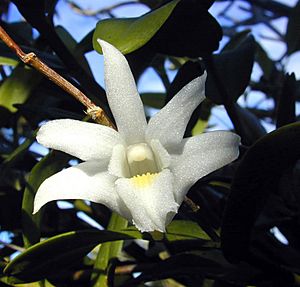Pigeon orchid facts for kids
Quick facts for kids Pigeon orchid |
|
|---|---|
 |
|
| Scientific classification | |
| Genus: |
Dendrobium
|
| Species: |
crumenatum
|
The pigeon orchid (scientific name: Dendrobium crumenatum) is a beautiful type of orchid. It's also known by its Chinese name, mu shi hu. This orchid grows on other plants, like trees, but it doesn't harm them. It's found naturally in many parts of Asia, Southeast Asia, New Guinea, and Christmas Island.
This special orchid has leaves arranged in two rows along its stem, which is called a pseudobulb. Its flowers are white, quite big, and smell very nice! But their scent only lasts for a short time. You can often find pigeon orchids growing in open, sunny spots in tropical forests and along coastlines.
Contents
What Does the Pigeon Orchid Look Like?
The pigeon orchid grows upright stems called pseudobulbs. These pseudobulbs can be about 30 to 70 centimeters (12 to 28 inches) long. They are a bit wider at the bottom, around 8 to 12 millimeters (0.3 to 0.5 inches) thick.
In the middle part of the pseudobulb, you'll find two rows of leathery leaves. These leaves are shaped like an oblong or an egg. They are usually 5 to 8 centimeters (2 to 3 inches) long and 1 to 2 centimeters (0.4 to 0.8 inches) wide.
The top part of the pseudobulb is where the pure white flowers appear. Each flower is about 3 to 4 centimeters (1.2 to 1.6 inches) long and wide. The top sepal and petals are around 1.5 to 1.8 centimeters (0.6 to 0.7 inches) long. The side sepals are a little bit longer and wider.
The flower also has a special lip, called a labellum. This lip is about 2 to 2.4 centimeters (0.8 to 0.9 inches) long and 1.3 to 1.5 centimeters (0.5 to 0.6 inches) wide. It has three parts, or lobes. The two side lobes stand up, and the middle lobe is round. This middle lobe has five yellow lines or ridges.
Pigeon orchids don't flower all the time. They usually bloom about nine days after the temperature suddenly drops by at least 5.5°C (10°F). This often happens after it rains. People can also make this happen by changing the temperature artificially. The flowers smell wonderful, but their scent only lasts for one day!
How Did It Get Its Name?
The pigeon orchid was first officially described in 1799. This was done by a scientist named Olof Swartz. He published his description in a science journal.
The scientific name for the pigeon orchid is Dendrobium crumenatum. The second part of the name, crumenatum, comes from a Latin word, crumena. This word means "leather moneybag."
Where Does the Pigeon Orchid Grow?
The pigeon orchid likes to grow in places where it gets a lot of sunlight. You can often find it in lowland rainforests or in coastal areas with scrubby plants.
This orchid is found in many countries. It grows in India, Indochina, Taiwan, the Philippines, Singapore, Malaysia, Indonesia, New Guinea, and Christmas Island. It has also started growing in other places like Fiji, Hawaii, the West Indies, and the Seychelles.
See also
 In Spanish: Dendrobium crumenatum para niños
In Spanish: Dendrobium crumenatum para niños

